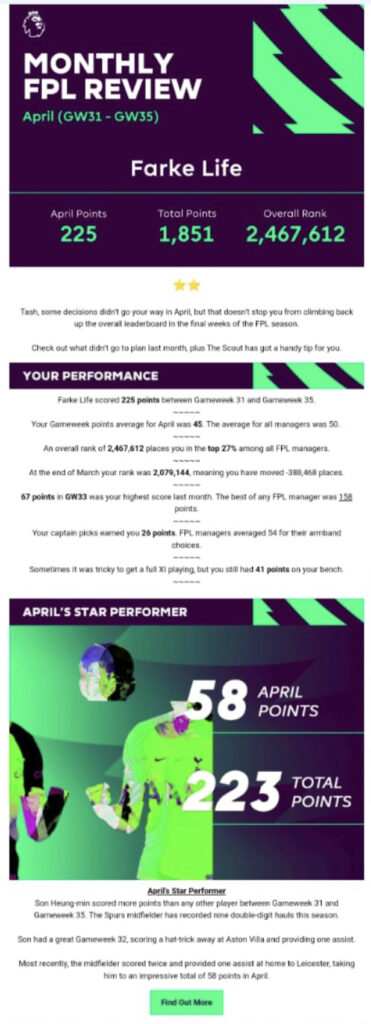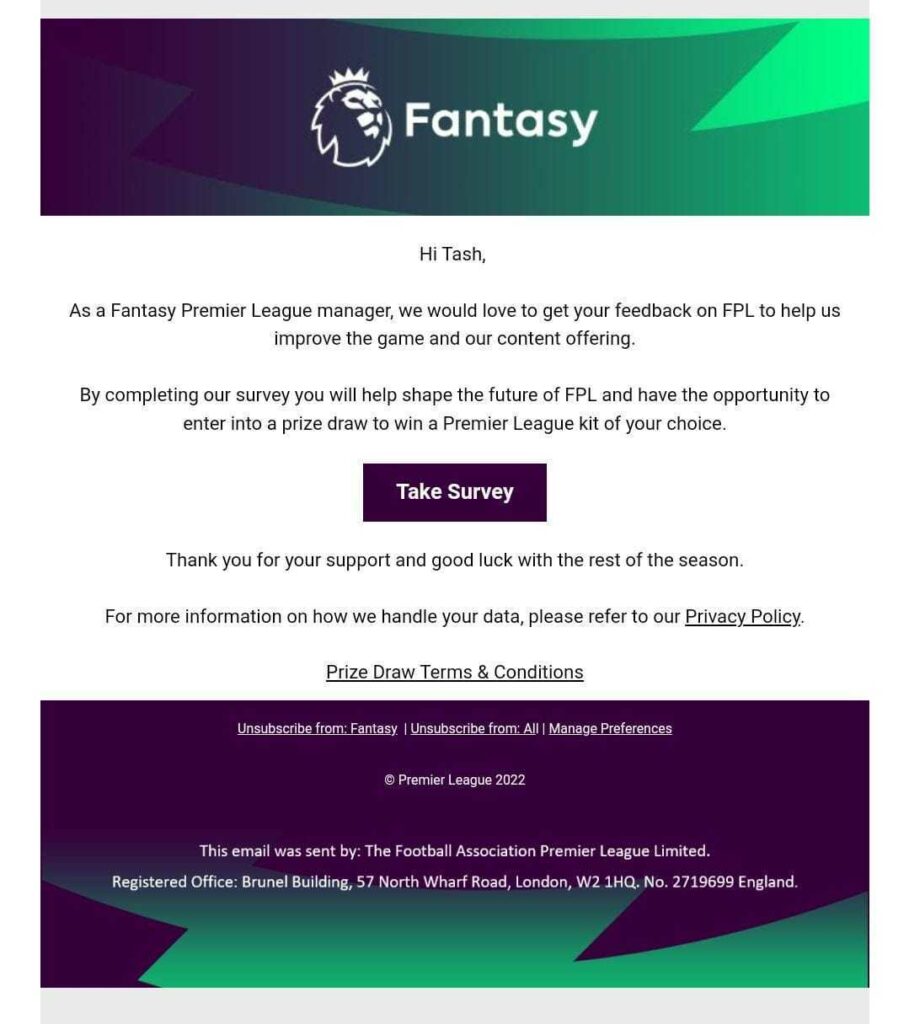

How using data in your campaigns will score you points

Many brands have a whole host of data, but aren’t always sure what to do with it. We’re always talking about using data to enrich your communications. Data doesn’t lie, it’s interesting, it’s powerful, and it can really improve your message.
Traditionally data is considered a bit dull, but we’re not talking about adding Excel spreadsheets to your newsletter. In fact, please never do that. But we are talking about weaving data into your overall message to add depth, authority, and impact.
Fantasy Premier League (FPL) do this fantastically. FPL, for the uninitiated, is exactly what it sounds like – a website and app that allows you to create a fantasy team alongside the English Premier League to earn points, create leagues to play against friends, and compete with other users all around the world. For many it’s just a bit of fun, for others it’s a serious deal, with FPL experts existing and sharing tips each week, it’s certainly a platform with invested fans.
FPL is a free-to-play service, so it makes its money through sponsorships and paid ads. This means that customer engagement could be flippant, and it’s also obviously incredibly seasonable. As a result, the brand needs to work really hard to keep users engaged, and as an email geek, I have to say it does a stellar job with its email campaigns.
Let’s take a look at some examples of how it does this.
Building excitement


This first email from FPL to kick off the season, was chock full of content. FPL start by building excitement, and then immediately let the reader know what to expect as the season progresses in terms of email communications, explaining what they will contain, and when they’ll be sent. FPL could have also linked to its preference center here to give readers a chance to reduce this if they wish, but it can be found in the footer so we’ll let them off.
The usage of data in this email is relatively basic as not much has happened yet, simply using first name personalization, and including the team name are nice touches to make the email feel informed and sophisticated. The email campaign also includes lots of content for readers to click through and consume in the run-up to the first game week, demonstrating value in the form of extra content for being subscribed.
Round-up reports


Each month FPL send out an email detailing your performance over the month. This campaign is a combination of generic stats across all players, and those tailored to the subscriber’s performance. This data covers both the previous month, and also includes a roundup of the season so far. The email also expertly utilizes personalization, with the opening copy clearly personalized with both first name, and written to reflect the reader’s personal performance over the month. This is a great level of personalization you don’t see often.
The email campaign isn’t just a reel of stats though, it also includes educational content you can click-through and read, another clear demonstration of the value you get for being subscribed. Also finishing off with a fun game, no doubt to encourage clicks, and a final helpful reminder and CTA present in the footer to keep users engaged.
A year’s worth of data


At the end of the season FPL send out a season round-up email, full of stats and insight. It sends out both a generic, and a personalized campaign. In this first one they once again make clear what’s to come, telling readers they can expect their personalized wrap-up that weekend.
The overall review campaign summarizes the whole season, with tons of stats and factoids. By including stats on how many other players were active this season, it builds the sense of community amongst readers.
The email, like all of their campaigns, is well designed and includes a gif rotating the ‘top performers’ to make the whole campaign feel super slick.
The email finishes off with a quiz, encouraging users to tweet them their score using the predetermined hashtag. This is a great use of cross-channel pollination. As the season is coming to an end, many users will be less interested in receiving emails, so FPL are aiming to get as many subscribers as possible to join them on other channels, in this case social media – thus widening their reach. It’s a smart move.
Make it personal


Next we have the personalized end-of-season wrap-up email. The campaign includes a huge amount of stats, personalized to the subscriber. Detailing things such as highest rank throughout the season, number of transfers made, and so on. The stats included are a collection of personal, the average, and the best for each particular stat. This gives a huge amount of information and context for the player, and perhaps even an ego boost if they have done particularly well. This is a really strong example of data usage, it provides the user with something valuable, something they wouldn’t get if they weren’t subscribed.
The email concludes with a thank you message. Knowing that this is likely the last email many will open for a while as it’s the end of the season, it’s a nice touch to thank subscribers and acknowledge them as real people. Even in this section they include some data, sharing how many others are playing, which builds on the feeling of community, and reinforces the brand’s position as the popular choice.
Data collection

FPL also use its emails to gather even more data. Of course it has a ton of behavioral data that is collected in-play, but not a lot of zero-party data.
This email was sent out to subscribers, asking them to share their thoughts. Surveys are often seen as a burden for consumers, FPL negate this with positive copy explaining the value exchange in completing it (getting to influence something you care about) and also add in a reward element with a prize draw.
Conclusion
FPL have shown how you can seamlessly include customer data to create an engaging campaign that adds real value to the subscriber. Of course not every brand has this much data on their customers, and sharing what you do have won’t always be appropriate, so take inspiration and see what could work for your brand.
Customers know that you have their personal data, and not all of them are comfortable with that. Increased privacy measures are being introduced by big tech companies to reflect consumer desire. Brands need to work hard to change this attitude. Brands should be innovating their communications, to show consumers that sharing their data is a good thing, and can benefit them.
In these examples FPL are simply sharing relevant data to inform, entertain, and engage the consumer. In other industries you can use the data you have to inform your content, ensuring consumers get emails that are relevant to them, and even make their life easier.
For example, in B2B you could use behavioral data such as webinar attendance or registration, to recognize a subscriber’s interest in a topic and use this to inform and influence the follow-up content you send to them.
Ultimately, email marketing has lots of tools available for you to create detailed, personalized campaigns your subscribers will enjoy, and you can do it at scale. So have a think about how you can utilize data to make your customers’ experience better, and create campaigns that prove data is anything but boring.
How to use data in your campaigns
Natasha Lainsbury
Stay on top
Get the latest and greatest marketing insight delivered to you weekly
Your email address will be handled in accordance with our Privacy Policy. We gather data around email opens & clicks using standard technologies including clear gifs to help us monitor and improve our newsletter.

